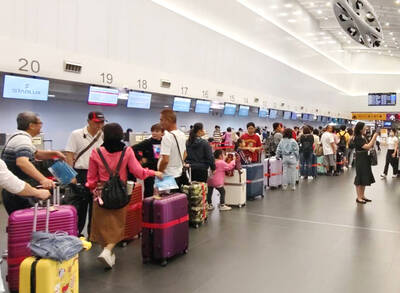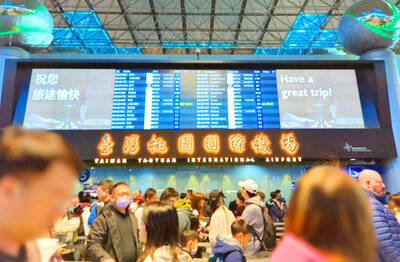Taiwanese Internet entrepreneur Hsueh Shao-lan (薛曉嵐) developed her picture-based method of learning Chinese characters in the hopes that it would help her UK-raised children pick up the language.
Three years later, the mother of two has found that her “Chineasy” program has a huge fan following, with tens of thousands of users viewing her Facebook page to learn new words and phrases and ask their questions about learning Chinese.
“I hope to help those with a fear of Mandarin to get rid of those feelings,” Hsueh said in an interview on Thursday.
The visual system she developed won the Life-Enhancer of the Year award from the UK’s Wallpaper* magazine,” beating out high-profile nominees like Google Inc’s Google Glass and Singapore Airlines’ first and business-class seats.
Chineasy has also been shortlisted for London-based Design Museum’s Designs of the Year this year.
Harper Design will be bringing out a print and ebook version of Chineasy: The New Way to Read Chinese, and an interactive app is also on the way, the author said.
The Chineasy method turns characters and their radicals — the smaller elements that make up each Chinese character — into illustrations to make them less intimidating and more memorable for learners of Chinese as a foreign language.
The method starts with 12 basic radicals — or as Hsueh calls them, “building blocks” — before teaching characters and then phrases built with them.
Learning characters by their radicals is not a new approach: Millions of people in Taiwan and China learn them, akin almost to spelling English words with letters.
However, what separates Hsueh’s system from rote classroom learning are her eye-catching illustrations, creative story-telling and touch of humor.
For example, in Chineasy, the radical for “person” (ren, 人) — a wishbone-shape made from lines that start opposite one another and move up to converge at the top — has had a bright red face added on top and red shoes at the bottom to clearly link the character to its meaning. For the radical for “mouth” (kou, 口) — a square shape — teeth and a tongue have been added on the inside.
As if the program is not appealing enough already, the illustrations are offered for free on Hsueh’s Web site and Facebook.
A team of about a dozen people, including illustrators and animators, has so far illustrated about 450 characters and phrases — a third of what Hsueh plans to accomplish, at least for now.
Hsueh left Taiwan for the UK in 2001 to study at the University of Cambridge.
She settled down there, working as an entrepreneur and venture capitalist while raising her two children, now aged nine and 11.
A few years ago, she found herself struggling to teach her native language to her children.
“They thought it was too hard and were not interested,” Hsueh said. “I tried many ways, but none of them worked, so I thought maybe I should think of something myself.”
The method she developed has received worldwide attention from media including the Financial Times and BBC, which caught wind of her unique approach after a TED talk she gave in California last year.
It is difficult to develop appealing illustrations for educational purposes, and Hsueh and her collaborators sometimes had to go through 20 versions of a character illustration before finding the right one.
“Giving birth to a character is like giving birth to a child,” Hsueh said.
Though she is interested in promoting her method, Hsueh is not looking to replace traditional ways of learning the language.
“I still hope most people will continue with how they were learning because there is a reason those ways exist,” she said, adding that her main goal is to introduce and inspire an interest in Chinese to help them learn faster.
The author is currently working on her second Chineasy book, after which she hopes to put her energies into developing methods to help people learn the proper pronunciation of Mandarin.

Three Taiwanese airlines have prohibited passengers from packing Bluetooth earbuds and their charger cases in checked luggage. EVA Air and Uni Air said that Bluetooth earbuds and charger cases are categorized as portable electronic devices, which should be switched off if they are placed in checked luggage based on international aviation safety regulations. They must not be in standby or sleep mode. However, as charging would continue when earbuds are placed in the charger cases, which would contravene international aviation regulations, their cases must be carried as hand luggage, they said. Tigerair Taiwan said that earbud charger cases are equipped

Foreign travelers entering Taiwan on a short layover via Taiwan Taoyuan International Airport are receiving NT$600 gift vouchers from yesterday, the Tourism Administration said, adding that it hopes the incentive would boost tourism consumption at the airport. The program, which allows travelers holding non-Taiwan passports who enter the country during a layover of up to 24 hours to claim a voucher, aims to promote attractions at the airport, the agency said in a statement on Friday. To participate, travelers must sign up on the campaign Web site, the agency said. They can then present their passport and boarding pass for their connecting international

Temperatures in northern Taiwan are forecast to reach as high as 30°C today, as an ongoing northeasterly seasonal wind system weakens, the Central Weather Administration (CWA) said. CWA forecaster Tseng Chao-cheng (曾昭誠) said yesterday that with the seasonal wind system weakening, warmer easterly winds would boost the temperature today. Daytime temperatures in northern Taiwan and Yilan County are expected to range from 28°C to 30°C today, up about 3°C from yesterday, Tseng said. According to the CWA, temperature highs in central and southern Taiwan could stay stable. However, the weather is expected to turn cooler starting tonight as the northeasterly wind system strengthens again

Taiwan sweltered through its hottest October on record, the Central Weather Administration (CWA) said yesterday, the latest in a string of global temperature records. The main island endured its highest average temperature since 1950, CWA forecaster Liu Pei-teng said. Temperatures the world over have soared in recent years as human-induced climate change contributes to ever more erratic weather patterns. Taiwan’s average temperature was 27.381°C as of Thursday, Liu said. Liu said the average could slip 0.1°C by the end of yesterday, but it would still be higher than the previous record of 27.009°C in 2016. "The temperature only started lowering around Oct. 18 or 19